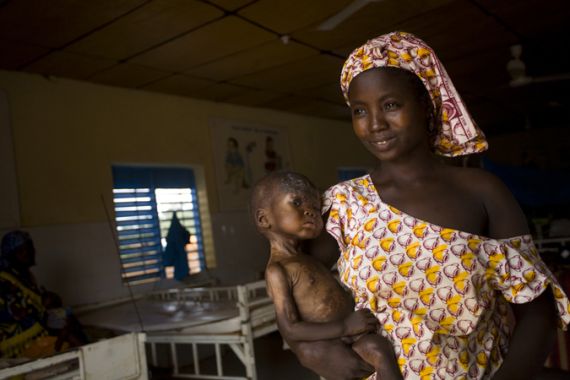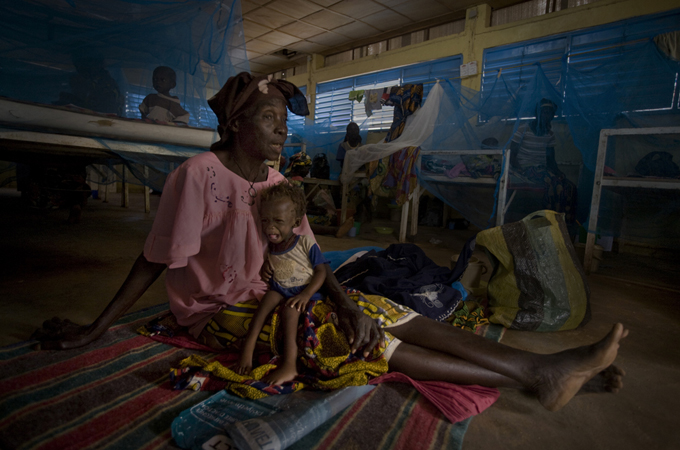Hunger crisis continues in Niger
As conference on hunger opens in London, thousands die in the African country, moving from one crisis to the next.

In the half-light of the malnutrition ward at Aguie’s district hospital, eleven-month old Yaha peers out at the world from under eyebrows crusted with open sores. In her short life, Yaha has known nothing but aching hunger: her mother brought her to the hospital when she became so ill that her skin began to fall away from her body.
Yaha is one of thousands of children who will be treated for severe malnutrition in Niger this year, as the country experiences yet another acute hunger crisis. But even on a good year, children like Yaha fill the hospital here. What the world defines as an emergency has become a bitter norm in Niger, a seasonal struggle that claims the lives of more than 200,000 children across the Sahel region every year.
On Sunday, world leaders, aid agencies and private sector delegates will gather in London for a summit to discuss new approaches to tackling global malnutrition. The summit will aim to leave an Olympic legacy that transcends sport, saving the lives of thousands of the world’s poorest children before the next Games in Rio in four years time.
|
“The problem is that much of the help they brought came too late and wasn’t in big enough quantities. To prevent malnutrition on the scale you see here, you need to get help more quickly.“ – Dr Adamou Magagi in Aguie, Niger |
Success hinges on a step-change in the world’s approach to hunger. Yaha, and others like her, are as much the victims of failed policy as natural calamity, and this must be recognised and addressed if real progress is to be made. It is no longer good enough to address Niger’s spells of hunger as separate disasters and respond to them accordingly. Niger needs long-term projects aimed at tackling the drivers of malnutrition – lack of social protection, over-reliance on rain-fed agriculture and a rapidly growing population – as well as short-term emergency relief.
The current approach of responding only to acute periods of crisis must be seen for what it is – too little, too late. For children like Yaha, it means that help is only available once food has run out, and for the doctors treating them, that is a source of major frustration. “The problem is that much of the help they brought came too late and wasn’t in big enough quantities,” says Dr Adamou Magagi, who runs the malnutrition ward in Aguie. “To prevent malnutrition on the scale you see here, you need to get help more quickly.”
His patients’ stories bear out the doctor’s stark diagnosis of Niger’s ills. Hadisa is a quiet woman who sits patiently on the floor of the malnutrition ward, bouncing her two-year old granddaughter, Salaha, on her bony knee as she talks. The child won’t stop crying, a good sign in a ward where the worst cases are silent bundles of skin and bone, heads lolling as they lie with their mothers on the rows of sheetless beds.
 |
| Two year-old Salaha cries as she sits with her grandmother in the stabilisation centre in Aguie, Niger [Andrew Wander] |
“Over the last twenty years things have got worse and worse, and it’s become so difficult to feed your family,” Hadisa says. “Some people in our village received aid. They were given cash, but we weren’t given any. If we’d received help earlier, Salaha wouldn’t be here. I would have fed her and been able to take care of her.”
It is a familiar refrain. On paper, every village in Aguie district is covered by a programme of cash transfers, rolled out at the beginning of the lean season to keep the poorest families from falling into dangerous levels of hunger. But in practice the programme is massively underfunded, and less than half of the families who qualify for cash support receive it. As the emergency deepens, more aid funding has become available, but for the weakest children, it is already too late.
Less than an hour’s drive from the hospital, in the middle of the village of Dan Rago, children gather by a pond of stagnant floodwater. The drought is over in Niger, and the rains are falling regularly across the south of country. In a few weeks, the millet harvest will begin; the journey to the village has taken us along tiny tracks cut through expanses of the crop, already head-high, though not yet edible.
“In two months time we will be able to harvest our crops, but they will only last for four to five months,” Idi Ali, the village chief, says. “That means we will run out of food again before the next harvest. And it’s the same every year.”
But there is no funding committed for next year’s hunger crisis, nor the one after that. The people of Dan Rago may be eking out a living on the cash transfers, but the programme is due to end with the harvest. There is no guarantee it will start again. The only thing that can be relied on is that there won’t be enough to eat.
And so it goes on. Unless long-term funding is made available to villages like Dan Rago, Niger will continue to lurch from emergency to emergency. In between the “crisis years”, thousands of children will die, and many more, like Yaha, will suffer the lifelong effects of childhood malnutrition. If delegates at the Olympic hunger summit are going to make a real difference, the reality faced by the people of Aguie, and places like it around the world, must be understood. Niger’s hungry are trapped in a perpetual crisis; an emergency that will not end until its causes, and not just its symptoms, are addressed.
Andrew Wander is Save the Children’s media manager for humanitarian emergencies and a former journalist with Al Jazeera.
Follow him on Twitter: @andrewwander
